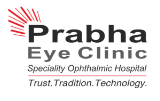Pediatrics Specialists:
- Dr. Krishna R Murthy
- Dr. Geethanjali C.J.
- Dr. Ajinkya V Deshmukh
More about Pediatric Ophthalmology
Congenital eye diseases include congenital / developmental cataracts, ptosis or drooping of eye lids, congenital nasolacrimal duct blockage (or NLD blockage) which results in watering of eyes. Newborns and younger infants commonly have some matting in their eyes and may have a lot of tearing; this could be because of blocked tear duct.
Amblyopia or lazy eye condition happens when visual function of one eye is underdeveloped. This could be successfully treated in early childhood as complications increase with age. It is difficult to identify a child suffering from amblyopia unless there is obvious misalignment. A thorough examination done by a specialist can help in analyzing this problem.
Retinopathy of Prematurity-condition occurs when a baby is born prematurely (less than 36 weeks of gestation) +/- those with birth weight less than 2000gm.The retina of the baby is screened in association with the NICU and action taken as necessary. Timely and prompt screening examination in these infants is crucial to prevent the vision threatening complications of the disease.
Pediatric strabismus or squint condition which can be identified when your child’s eyes point in different directions. If it is not treated in time, it could lead to lazy eye (suboptimal vision and potential blindness), double vision, eye strain, discomfort and headache. Squint also hampers binocular vision development and child may never have 3D vision if squint is left untreated. It’s a myth that squint disappears in few years by its own. No, it does not. Early diagnosis and appropriate treatment of squint is critical to have best outcomes.
How is the squint treated?
There are various ways of treating different types of squint. The treatment plan depends on type of squint, age of onset of squint, degrees / amount of squint, control over the squint and vision. All squints need and have treatment irrespective of type and amount of squint. Some squints can be totally corrected by prescribing correct glass power. Few squints can be managed by patching exercises to improve the vision and the control over squint. While few squints require surgery on eye muscles to achieve the eye alignment. Squint surgery is one of the safest surgeries in eye and has good success rate. Time is the key- earlier the treatment of squint, better is the overall outcome. Squint can also impact psychosocial development of your child. Treating the squint in time improves their confidence and scholastic performance, as well.There are various ways of treating different types of squint. The treatment plan depends on type of squint, age of onset of squint, degrees / amount of squint, control over the squint and vision. All squints need and have treatment irrespective of type and amount of squint. Some squints can be totally corrected by prescribing correct glass power. Few squints can be managed by patching exercises to improve the vision and the control over squint. While few squints require surgery on eye muscles to achieve the eye alignment. Squint surgery is one of the safest surgeries in eye and has good success rate. Time is the key- earlier the treatment of squint, better is the overall outcome. Squint can also impact psychosocial development of your child. Treating the squint in time improves their confidence and scholastic performance, as well.

Orthoptic and binocular vision therapy
Binocular vision therapy and orthoptic therapy is a treatment program that strengthens the neural connections between eyes and the brain, and enhances the performance of visual skills. These therapies are used to treat. We have a well-established set up to cater to different eye diseases like convergence and accommodation insufficiency / excess, eye fatigue, lazy eye, impaired eye tracking, poor depth perception and 3D vision, double vision and various types of squints. We also have Orthoptek machine which is also helpful in treating these conditions with better efficiency.
Outreach and screening programs
We also conduct school eye screening programs and other outreach programs. A dedicated team of optometrists and doctors go to school and other distant locations with all the necessary screening equipment and do the eye screening examinations on site. These routine and timely screening examinations help detect the eye diseases in time, and reduce the vision problem significantly by prompt and effective treatment.
Adult Strabismus
Strabismus is a defect in the eyes wherein the eyes point in two different directions. Our strabismus patients receive comprehensive diagnosis and management of their ocular misalignment and diplopia. The treatment for Strabismus varies accordingly to the type of squint.
Strabismus can be either due to any craniomotor nerve palsies, any mechanical causes like fracture or bones of orbit, thyroid eye disease, neuro-muscular problems like myasthenia or due sensory strabismus due to poor vision.
The different types of treatment are:
- Spectacles which is used to correct sight problems.
- Occlusion – patching the good eye to encourage the weaker eye to be used.
- Surgery
Surgery is done in cases of congenital squints with other forms of treatment. During surgery a small incision is made in the tissue covering the eye to reach the eye muscles the eye muscles are removed from the wall of the eye and repositioned during the surgery, depending on which direction the eye is turning. Sometimes, it may be necessary to perform surgery on one or both eyes. Surgery in children in performed under general anesthesia.






